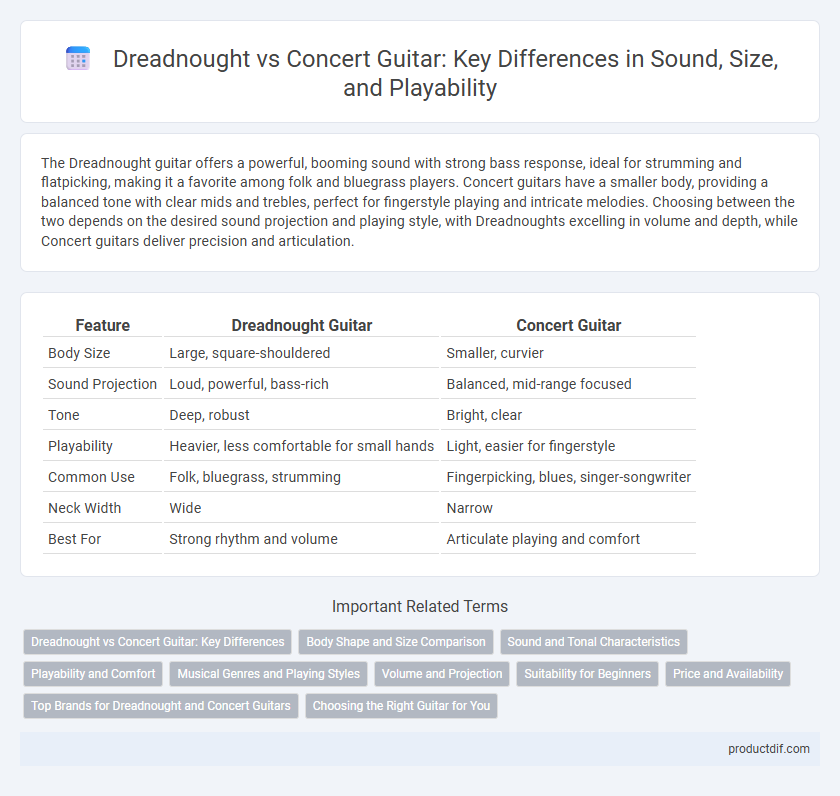The Dreadnought guitar offers a powerful, booming sound with strong bass response, ideal for strumming and flatpicking, making it a favorite among folk and bluegrass players. Concert guitars have a smaller body, providing a balanced tone with clear mids and trebles, perfect for fingerstyle playing and intricate melodies. Choosing between the two depends on the desired sound projection and playing style, with Dreadnoughts excelling in volume and depth, while Concert guitars deliver precision and articulation.
Table of Comparison
| Feature | Dreadnought Guitar | Concert Guitar |
|---|---|---|
| Body Size | Large, square-shouldered | Smaller, curvier |
| Sound Projection | Loud, powerful, bass-rich | Balanced, mid-range focused |
| Tone | Deep, robust | Bright, clear |
| Playability | Heavier, less comfortable for small hands | Light, easier for fingerstyle |
| Common Use | Folk, bluegrass, strumming | Fingerpicking, blues, singer-songwriter |
| Neck Width | Wide | Narrow |
| Best For | Strong rhythm and volume | Articulate playing and comfort |
Dreadnought vs Concert Guitar: Key Differences
The Dreadnought guitar features a larger body size and a deeper, bass-rich sound, making it ideal for powerful strumming and flatpicking styles. In contrast, the Concert guitar offers a smaller body with a balanced tonal response and enhanced midrange clarity, preferred for fingerpicking and intricate playing. Differences in body shape, projection, and tonal emphasis define the unique acoustic characteristics between Dreadnought and Concert guitars.
Body Shape and Size Comparison
Dreadnought guitars feature a larger, square-shouldered body shape that produces a bold, powerful sound ideal for strumming and flatpicking. Concert guitars have a smaller, more curvaceous body with a narrower waist, offering a balanced tone and greater comfort for fingerstyle playing. The size difference affects projection and tonal response, making dreadnoughts louder and bass-heavy, while concert models emphasize clarity and midrange detail.
Sound and Tonal Characteristics
Dreadnought guitars produce a bold, powerful sound with strong bass response and pronounced projection, making them ideal for strumming and flatpicking in genres like folk and country. Concert guitars offer a brighter, more balanced tonal profile with clear midrange emphasis and enhanced articulation, favored for fingerstyle playing and intricate melodies. The size and body shape directly influence the tonal resonance; dreadnoughts feature larger bodies for deeper, fuller tones while concert guitars have smaller frames that enhance clarity and precision.
Playability and Comfort
Dreadnought guitars feature a larger body and thicker neck, offering powerful projection but often sacrificing some playability and comfort for players with smaller hands. Concert guitars have a slightly smaller, more contoured body and narrower neck, enhancing comfort and ease of play, especially for fingerstyle techniques and extended playing sessions. The ergonomic design of concert guitars makes them ideal for musicians seeking a balance between sound quality and comfortable performance.
Musical Genres and Playing Styles
Dreadnought guitars, with their powerful bass response and robust volume, excel in genres like folk, country, and bluegrass, supporting strumming and flatpicking styles that require projection and rhythmic emphasis. Concert guitars, characterized by a balanced tone and more focused midrange, are preferred for fingerstyle and classical playing, delivering clarity and articulation suited for intricate melodies and soft dynamics. Musicians choose Dreadnoughts for energetic ensemble settings and Concert guitars for solo performances that highlight subtle nuances and expressive control.
Volume and Projection
Dreadnought guitars deliver a powerful volume and robust projection due to their larger body size and deeper sound chamber, making them ideal for strumming and outdoor performances. Concert guitars feature a smaller body that produces a more focused, balanced tone with moderate volume, suited for fingerstyle playing and intimate settings. The difference in size directly impacts the sound projection, with dreadnoughts offering broader sound dispersion versus the concert's controlled and clear acoustic output.
Suitability for Beginners
Dreadnought guitars feature a larger body size, producing a louder and fuller sound, which can be challenging for beginners to handle due to their bulk and string tension. Concert guitars offer a smaller, more comfortable body shape with a slimmer neck, making them more suitable for beginners who prioritize ease of play and finger flexibility. Beginners seeking balanced sound and reduced physical strain often find concert guitars a better starting choice for learning.
Price and Availability
Dreadnought guitars typically range from $200 to $1,500, offering broad availability in both entry-level and premium models, making them accessible in most music stores and online platforms. Concert guitars, often priced between $300 and $2,000, may have a more limited selection especially in budget ranges, but specialized shops and boutique brands frequently carry them. Both types are widely available, with dreadnoughts dominating mass-market inventory due to their popularity and versatility.
Top Brands for Dreadnought and Concert Guitars
Top brands for Dreadnought guitars include Martin, Taylor, and Gibson, known for their robust sound and durability, ideal for strumming and flatpicking. Concert guitars are prominently produced by Yamaha, Cordoba, and Takamine, offering balanced tones and comfortable playability suited for fingerstyle and intricate melodies. Both styles feature high-quality woods like Sitka spruce and mahogany, enhancing their distinctive tonal characteristics favored by professionals.
Choosing the Right Guitar for You
Selecting between a Dreadnought and Concert guitar depends on your playing style and tonal preferences. Dreadnought guitars offer a powerful, bass-heavy sound ideal for strumming and flatpicking, while Concert guitars provide a balanced, articulate tone suited for fingerpicking and intricate playing. Consider body size comfort and sound projection to match your musical needs and physical ease.
Dreadnought vs Concert guitar Infographic

 productdif.com
productdif.com